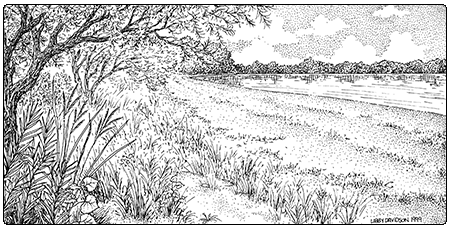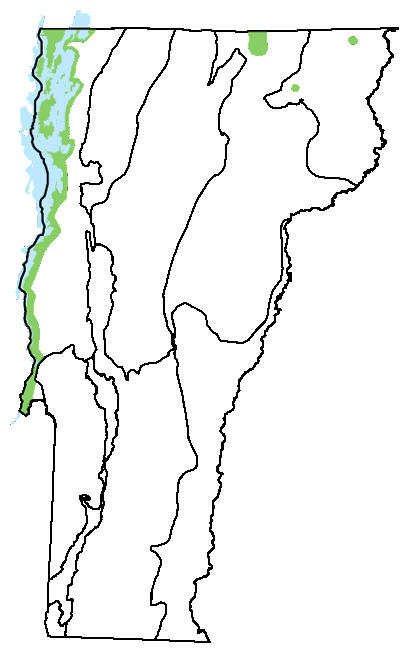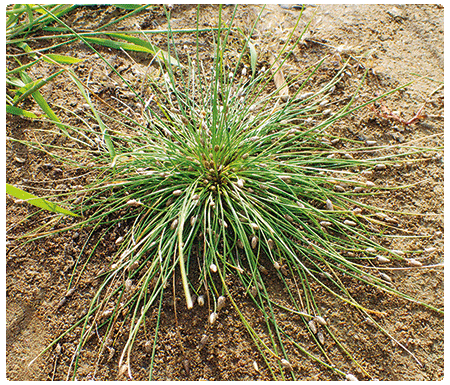Ecology and Physical Setting
The formation of a Lake Sand Beach requires two things: a supply of sand and a way for the sand to be moved about. A river or stream entering a lake may carry enough sediment to supply a beach system; wave action on existing bluffs may release still more. The sand that supplies Lake Sand Beaches in northern Lake Champlain probably comes from the major rivers, especially the Lamoille and the Winooski. The largest and best Lake Sand Beaches on Lake Champlain are found on south facing shores, where prevailing southerly winds provide a constant supply of sand as well as the disturbance necessary to keep the communities open.
A typical Lake Sand Beach has a relatively flat area, including a beach face that receives wave action, and a beach berm above it. There may also be a higher dune field above the berm. Behind the berm, or dune field if there is one, there may be a wetland, a cliff, or a bedrock feature.
In dry years, when lake levels are low, extensive sand and mud flats can be exposed. These lower beaches are wetlands, and they support a surprisingly diverse array of annual plants—many of which are rare in Vermont—that do best on a fine, muddy substrate. Their seeds may have waited underwater for many years until the sediments were exposed.
 Beaches change and move over time, responding to wind, storms, and currents. There may be more sand movement on a beach with a wetland behind it than on one backed by a confining bedrock cliff or ridge. In fact, it seems that the best developed beaches on Vermont lakes are those that sit at the lakeward edges of wetlands that occupy old lake coves. We have examined aerial photographs of one such beach, and the pictures show that sand has been blowing for many years back into the wetland. When we dig deep beneath the sand on this beach, we find peat, or wetland deposits, that have over thousands of years been buried by the sand. It is likely that some other sand beaches have peat beneath them.
Beaches change and move over time, responding to wind, storms, and currents. There may be more sand movement on a beach with a wetland behind it than on one backed by a confining bedrock cliff or ridge. In fact, it seems that the best developed beaches on Vermont lakes are those that sit at the lakeward edges of wetlands that occupy old lake coves. We have examined aerial photographs of one such beach, and the pictures show that sand has been blowing for many years back into the wetland. When we dig deep beneath the sand on this beach, we find peat, or wetland deposits, that have over thousands of years been buried by the sand. It is likely that some other sand beaches have peat beneath them.
A low spot on a beach where water collects may show evidence of a peaty undersoil, too. Water can move laterally through the sand and the peat, picking up tannic acids from the peat and emerging brown at the surface. These low places can be well vegetated with a number of wetland-loving plants, and in some cases they may be wetlands.
Artificial sand beaches have been created in a number of places on different lakes by trucking in sand. With their anthropogenic origin and lack of native vegetation, these are not considered natural communities.
Vegetation

on sand beaches of the Atlantic coast.
If a beach is not completely reshaped annually by blowing sand, it is at least scoured regularly by lake ice pushing upward onto the shore. Ice-scour, flooding, and wind combine to keep the permanent vegetation on a beach to a minimum. At the upper edge of most beaches, cottonwoods, willows, and other trees survive in a narrow, forested strip, but these often bear the scars of ice damage at their bases. A beach can also have bands of low shrubs closer to the water—willows are common. These bands may be short-lived, surviving for only a few years between major spring floods.
Many of the herbs found on a sand beach are annuals. Nodding bur marigold and clammyweed are examples. Annuals are well adapted to an environment where the substrate may completely shift from one year to the next and where flooding can last a long time in the spring. More stable areas, and places that are higher and less flood prone, have perennial herbs such as silverweed and freshwater cordgrass, along with shrubs and tree saplings.
Wildlife Habitat
Spotted sandpipers are commonly found feeding on beaches, where small insects are abundant. Several species of gull also frequent Lake Champlain beaches and the nearshore waters, where they rest and feed. Raccoons are common along the shore and their distinct, long-toed tracks in the wet sand are good evidence of their passing. Several species of turtles dig nests in sand beaches to lay their eggs, including snapping turtle and two rare species, spiny softshell and northern map turtle. Beaches with lots of human activity and disturbance make poor nesting habitat for most turtles. The open sand on beaches is used by the common shore tiger beetle and has also historically supported the very rare hairy-necked tiger beetle. Several cosmopolitan damselflies and dragonflies are found on and over Lake Sand Beaches and the water nearby.
Related Communities
- Sand Dunes are associated with the larger Lake Sand Beaches on Lake Champlain, and these two communities are very closely related, both in geomorphology and in vegetation. Sand Dunes are much drier overall, as they are above the influence of seasonal high water. Typically, their vegetation is denser than the vegetation of Lake Sand Beaches.
- Lake Shale or Cobble Beach shares similar vegetation but is distinguished by substrate. These two communities often occur in close proximity.
- Lakeshore Grassland: Wetter or more stable parts of Lake Sand Beaches may be very similar to Lakeshore Grasslands, which have denser and more permanent vegetation than sand beaches. The two communities can be found at the same site with the grassland occurring landward of the beach.
Conservation Status and Management Considerations
Lake Sand Beaches are rare in Vermont. Most good examples have been developed as recreation areas, either with private homes or with public swimming facilities. Fortunately, Vermont’s largest remaining Lake Sand Beach, along with its dune system, is protected at Alburgh Dunes State Park, where restoration and ecological management are ongoing. Very few other beaches in public ownership are protected as natural areas. Owners of private sand beaches can maintain them as natural communities by avoiding building in areas of moving sand, avoiding any grading or clearing, and allowing natural vegetation to grow.
Distribution/Abundance
The largest and most important Lake Sand Beaches in the state are on Lake Champlain, but there are a few excellent examples on other lakes, particularly Lake Memphremagog, Averill Lake, Little Averill Lake, and Lake Willoughby. Freshwater sand beaches of similar species composition are found throughout the Northeast. Magnificent examples are found on the Great Lakes.
Characteristic Plants
Trees
Black willow – Salix nigra
Cottonwood – Populus deltoides
American elm – Ulmus americana
Boxelder – Acer negundo
Green ash – Fraxinus pennsylvanica
White ash – Fraxinus americana
Shrubs
Sandbar willow – Salix interior
Shining willow – Salix lucida
Woolly-headed willow – Salix eriocephala
Herbs
Silverweed – Argentina anserina
Spreading dogbane – Apocynum androsaemifolium
Freshwater cordgrass – Spartina pectinata
Cocklebur – Xanthium strumarium
Clammyweed – Polanisia dodecandra
Common beggar’s-ticks – Bidens frondosa
Nodding bur marigold – Bidens cernua
Tall beggar’s ticks – Bidens vulgata
Yellow nutsedge – Cyperus esculentus
Two-parted cyperus – Cyperus bipartitus
Three-way sedge – Dulichium arundinaceum
Poison ivy – Toxicodendron radicans
Sand dropseed – Sporobolus cryptandrus
Groundnut – Apios americana
Grass-leaved water plantain – Alisma gramineum
Galingale – Cyperus strigosus
Water star-grass – Heteranthera dubia
Non-native Plants
Crack willow – Salix ×fragilis
Downy chess – Bromus tectorum
Butter-and-eggs – Linaria vulgaris
Rare and Uncommon Plants

on the lower, wetter portions of Lake Sand Beaches.
Creeping lovegrass – Eragrostis hypnoides
Beach pea – Lathyrus japonicus
Champlain beach grass – Ammophila breviligulata ssp. champlainensis
Matted spikerush – Eleocharis intermedia
Umbrella flatsedge – Cyperus diandrus
Ovate spikerush – Eleocharis ovata
Sandbur – Cenchrus longispinus
Beach wormwood – Artemisia campestris ssp. caudata
Smith’s bulrush – Schoenoplectiella smithii var. smithii
Hay sedge – Carex siccata
Awned cyperus – Cyperus squarrosus
Creeping lovegrass – Eragrostis hypnoides
Wright’s spikerush – Eleocharis diandra
Three-parted beggar’s-ticks – Bidens tripartita
Redroot flatsedge – Cyperus erythrorhizos
Marsh vetchling – Lathyrus palustris
Tuckerman’s witchgrass – Panicum tuckermanii
Fragrant sedge – Cyperus odoratus
Cursed crowfoot – Ranunculus sceleratus
Grass-leaved water plantain – Alisma gramineum
White water-crowfoot – Ranunculus aquatilis
Water hemp – Amaranthus tuberculatus
Associated Animals
Snapping turtle – Chelydra serpentina
Painted turtle – Chrysemys picta
Raccoon – Procyon lotor
Mink – Neovison vison
Spotted sandpiper – Actitis macularius
Great black-backed gull – Larus marinus
Herring gull – Larus argentatus
Ring-billed gull – Larus delawarensis
Canada goose – Branta canadensis
Eastern forktail – Ischnura verticalis
Variable dancer – Argia fumipennis
Common whitetail – Plathemis lydia
Common shore tiger beetle – Cicindela repanda
Rare and Uncommon Animals
Spiny softshell – Apalone spinifera
Northern map turtle – Graptemys geographica
Hairy-necked tiger beetle – Cicindela hirticollis
Places to Visit
Alburgh Dunes State Park, Alburgh, Vermont Department of Forests, Parks, and Recreation (VDFPR)
North Beach, Burlington, City of Burlington Department of Parks and Recreation
Willoughby State Forest, Westmore, VDFPR
Niquette Bay State Park, Colchester, VDFPR
